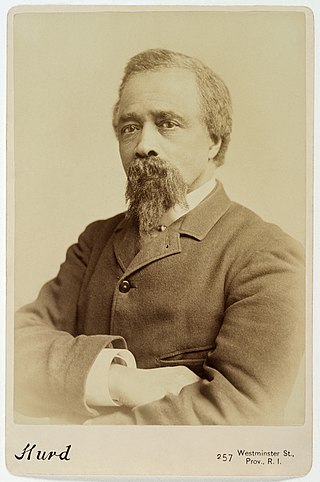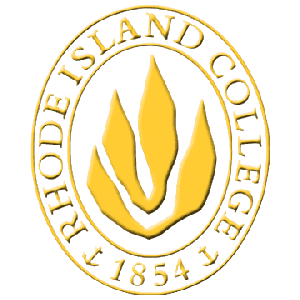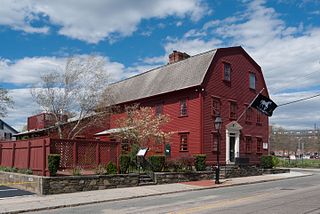Education in Rhode Island covers the public and private schools at all levels from the colonial era to the present.
Contents
- History
- Primary and secondary schools
- Colleges and universities
- See also
- Notes
- Further reading
- External links

Education in Rhode Island covers the public and private schools at all levels from the colonial era to the present.

Rhode Island has several colleges and universities:

Brown University is a private Ivy League research university in Providence, Rhode Island. It is the seventh-oldest institution of higher education in the United States, founded in 1764 as the College in the English Colony of Rhode Island and Providence Plantations. One of nine colonial colleges chartered before the American Revolution, it was the first college in the United States to codify in its charter that admission and instruction of students was to be equal regardless of their religious affiliation.

Edward Mitchell Bannister was a Canadian–American oil painter of the American Barbizon school. Born in Canada, he spent his adult life in New England in the United States. There, along with his wife Christiana Carteaux, he was a prominent member of African-American cultural and political communities, such as the Boston abolition movement. Bannister received national recognition after he won a first prize in painting at the 1876 Philadelphia Centennial Exhibition. He was also a founding member of the Providence Art Club and the Rhode Island School of Design.

Rhode Island is a state in the New England region of the Northeastern United States. It is the smallest U.S. state by area and the seventh-least populous, with slightly fewer than 1.1 million residents as of 2020; but Rhode Island has grown at every decennial count since 1790 and is the second-most densely populated state, after New Jersey. The state takes its name from the eponymous island, though nearly all its land area is on the mainland. Rhode Island borders Connecticut to its west; Massachusetts to its north and east; and the Atlantic Ocean to its south via Rhode Island Sound and Block Island Sound; and shares a small maritime border with New York, east of Long Island. Providence is its capital and most populous city.

Roger Williams was an English-born New England Puritan minister, theologian, and author who founded Providence Plantations, which became the Colony of Rhode Island and Providence Plantations and later the State of Rhode Island and Providence Plantations. He was a staunch advocate for religious freedom, separation of church and state, and fair dealings with the Native Americans.

Barrington is a suburban, residential town in Bristol County, Rhode Island, United States, located approximately 7 miles (11 km) southeast of Providence. It was founded by Congregationalist separatists from Swansea, Massachusetts, and incorporated in 1717.

Rhode Island College (RIC) is a public college in Rhode Island, which much of the land in Providence, and other parts in North Providence. The college was established in 1854 as the Rhode Island State Normal School, making it the second oldest institution of higher education in Rhode Island after Brown University. Located on a 180-acre campus, the college has a student body of 9,000: 7,518 undergraduates and 1,482 graduate students. RIC is a member of the NCAA and has 17 Division III teams.

The Rhode Island School of Design is a private art and design school in Providence, Rhode Island. The school was founded as a coeducational institution in 1877 by Helen Adelia Rowe Metcalf, who sought to increase the accessibility of design education to women. Today, RISD offers bachelor's and master's degree programs across 19 majors and enrolls approximately 2,000 undergraduate and 500 graduate students. The Rhode Island School of Design Museum—which houses the school's art and design collections—is one of the largest college art museums in the United States.

Thomas Williams Bicknell was an American educator, historian, and author.

Thomas Alexander Tefft was an American architect, from Providence, Rhode Island. Tefft, one of the nation's first professionally trained architects, is considered a master of Rundbogenstil and a leading American proponent of its use. Prior to his untimely death, Tefft "offered the most advanced designs of [his] day in America"

The Smithville Seminary was a Freewill Baptist institution established in 1839 on what is now Institute Lane in Smithville-North Scituate, Rhode Island. Renamed the Lapham Institute in 1863, it closed in 1876. The site was then used as the campus of the Pentecostal Collegiate Institute and later the Watchman Institute, and is now the Scituate Commons apartments. It was placed on the National Register of Historic Places in 1978.

The history of Rhode Island is an overview of the Colony of Rhode Island and Providence Plantations and the state of Rhode Island from pre-colonial times to the present.

College Hill is a historic neighborhood of Providence, Rhode Island, and one of six neighborhoods comprising the city's East Side. It is roughly bounded by South and North Main Street to the west, Power Street to the south, Governor Street and Arlington Avenue to the east and Olney Street to the north. The neighborhood's primary commercial area extends along Thayer Street, a strip frequented by students in the Providence area.

Charles Value Chapin was an American pioneer in public health research and practice during the Progressive Era. He was superintendent of health for Providence, Rhode Island between 1884 and 1932. He established one of the earliest municipal public health laboratories in 1888, and the Providence City Hospital for contagious diseases in 1910. Chapin taught at Brown University and Harvard. In 1927 he served as president of the American Public Health Association and as the first president of the American Epidemiological Society.

The University of Rhode Island (URI) is a public land-grant research university with its main campus in Kingston, Rhode Island, United States. It is the flagship public research as well as the land-grant university of Rhode Island. The university is classified among "R2: Doctoral Universities – High research activity". As of 2019, the URI enrolled 14,653 undergraduate students, 1,982 graduate students, and 1,339 non-degree students, making it the largest university in the state.

Market Square is a market square in Providence, Rhode Island. It is located at the intersection of present-day North Main Street and College Street at the base of College Hill. Market Square has historically functioned as a commercial, civic, and cultural locus of Providence.

Providence is the capital and most populous city of the U.S. state of Rhode Island. The county seat of Providence County, it is one of the oldest cities in New England, founded in 1636 by Roger Williams, a Reformed Baptist theologian and religious exile from the Massachusetts Bay Colony. He named the area in honor of "God's merciful Providence" which he believed was responsible for revealing such a haven for him and his followers. The city developed as a busy port, as it is situated at the mouth of the Providence River at the head of Narragansett Bay.

The history of Brown University spans 259 years. Founded in 1764 as the College in the English Colony of Rhode Island and Providence Plantations, Brown is the seventh-oldest institution of higher education in the United States and the third-oldest institution of higher education in New England. At its foundation, the university was the first in the U.S. to accept students regardless of their religious affiliation. Brown's medical program is the third-oldest in New England while its engineering program is the oldest in the Ivy League.

Sarah Elizabeth Doyle was an American educator and educational reformer, noted for her roles in founding the Rhode Island School of Design and establishing women's education at Brown University.
Thomas Blanchard Stockwell (1839–1906) was an important citizen of Rhode Island, serving for thirty years as the Eighth Commissioner of Public Schools.